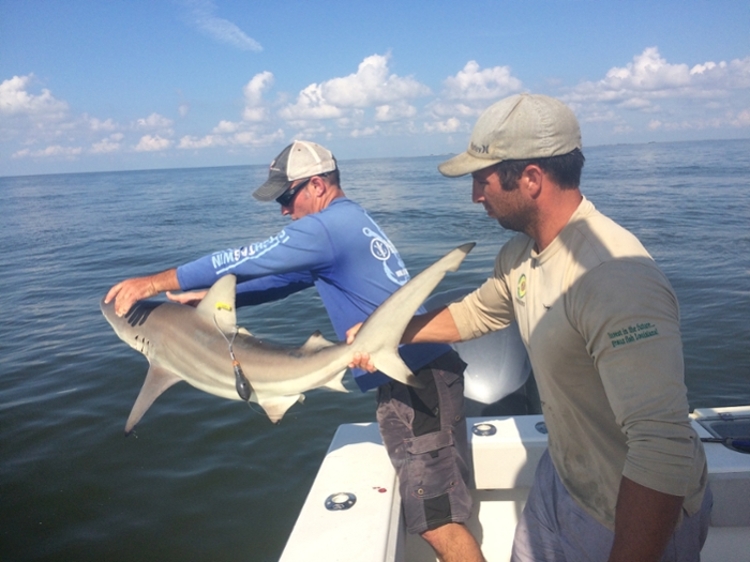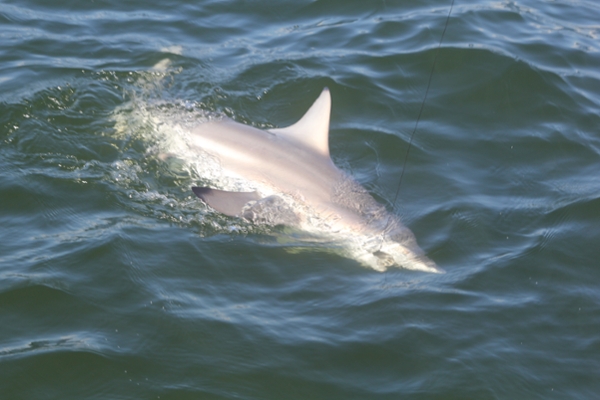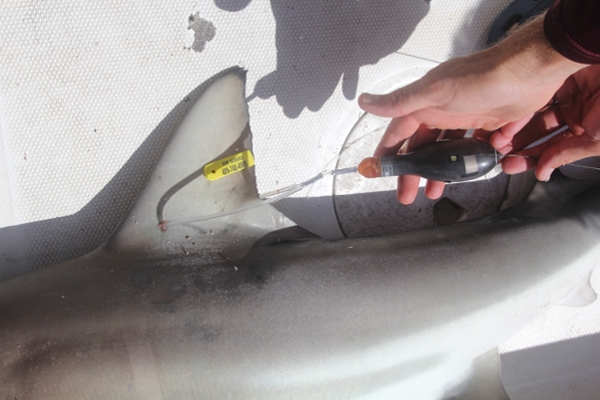Texas A&M-Galveston Shark Study Aims to Help Anglers Avoid Accidental Animal Death
June 10, 2020
Tweet
By Andréa Bolt, Communications Specialist, Division of Marketing & Communications
Give a man a fish and you feed him for a day; teach a man to fish and you feed him for a lifetime, goes the old adage. But even more important is the experience level of the fisher — the better the fisher, the better the chance the shark on the other end of the line will live to swim another day.
That’s part of the conclusion of Texas A&M University at Galveston’s Dr. John Mohan recently-published paper, “Capture stress and post-release mortality of blacktip sharks in recreational charter fisheries of the Gulf of Mexico.”
Mohan works as an assistant research scientist in the Shark Biology & Fisheries Science Lab run by the Department of Marine Biology’s Dr. David Wells. The shark scientists were awarded a grant by the National Oceanic & Atmospheric Administration (NOAA) to help assess numbers of the migratory blacktip species and better ascertain how certain recreational catch-and-release fishing practices are contributing to post-release deaths in blacktips.

Blacktip sharks are one of the most common shark species found in the warm Gulf of Mexico waters, making them popular in the commercial fishery and recreational sportfishing circuit. These agile animals grow around six feet in length and weigh anywhere from 70 to over 200 pounds, making them an ideal catch for both experienced and novice fishers.
But after Mohan and Wells boarded charter fishing boats in Galveston and observed how different anglers treated sharks they got on a line and what happened after those animals were released, they realized the sharks needed to be handled with more care.
“As soon as they would hook up and the fight time stopped, the shark was brought out of the water and onto the boat, we weren’t telling them (the anglers or captains) what to do,” Mohan said, explaining the details of the study.
For the study, Mohan and Wells observed different charter companies’ catch-and-release techniques in Texas, Louisiana and Florida, and also captured crucial biological information like blood samples from a percentage of the blacktips that were hooked. The goal was to determine what physiological factors were causing some of the sharks to overstress and die.
Of the 52 sharks they collected samples from, 36 were outfitted with pop-up satellite archival transmitting (PSAT) tags to track what happened after the sharks were released back into the water.

“It was really fascinating. There were two types of mortalities, one where the shark would go immediately to the bottom and die, and a delayed reaction. In somewhere from a few hours up to 14 hours, they would die,” said Mohan. “The blood chemistry revealed that those that died immediately were already stressed, and those that experienced the delayed death had similar blood physiology to survivors. We saw that the health or condition of the shark before capture plays a big role, and a sick shark has a higher chance of dying compared to a healthy one.”
The post-release mortality rate derived was 23%, similar to another study conducted on blacktips in the Atlantic Ocean, which found 19% died after similar catch-and-release techniques were employed by similarly-experienced fishing crews. But in the other study that employed highly-experienced charter crews and captains who handled the animals according to new regulations, the mortality rate dropped to 9.7%.
These regulations, recently introduced in Florida, validate the observations and conclusions made by Mohan and Wells.
“They’re encouraging anglers to keep the sharks in the water, stay away from the gill area and to try to handle them as little as possible. How the sharks are handled matters and the experience level of the angler and tackle used matters,” he said.
The success of this study has spurred another similar project, also funded by NOAA, who now want to explore similar factors touched on in this project, but through shore-based fishing practices. The mortality rate for sharks caught via shore-based fishing is unknown, Mohan said.
This study will be larger in scope. Mohan said they’ll be working in collaboration with Texas A&M University - Corpus Christi and its Harte Research Institute, as well as with the public, who he says will act as citizen scientists and can help by calling the number on tags they find washed up on the beach.
Unfortunately, the study has been delayed due to the COVID-19 pandemic, but Mohan is still thrilled to be tagging all of next year.
“It’s exciting to continue the research. For that study, we are tagging blacktips, bull sharks, scalloped hammerheads and tiger sharks as additional species because they all have different responses to stress and fishing.”
###
Media contact:Communications Specialist
a_bolt@tamug.edu
More:
Read more about Health & Environment
Read more about Marine Biology
Read more about Marine Sciences